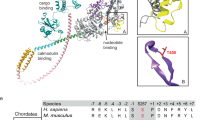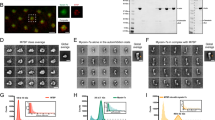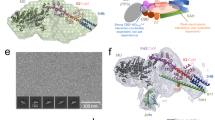Abstract
Upon encountering an antigen, motile T cells stop crawling, change morphology and ultimately form an 'immunological synapse'. Although myosin motors are thought to mediate various aspects of this process, the molecules involved and their exact roles are not defined. Here we show that nonmuscle myosin heavy chain IIA, or MyH9, is the only class II myosin expressed in T cells and is associated with the uropod during crawling. MyH9 function is required for maintenance of the uropod and for T cell motility but is dispensable for synapse formation. Phosphorylation of MyH9 in its multimerization domain by T cell receptor–generated signals indicates that inactivation of this motor may be a key step in the 'stop' response during antigen recognition.
This is a preview of subscription content, access via your institution
Access options
Subscribe to this journal
Receive 12 print issues and online access
$209.00 per year
only $17.42 per issue
Buy this article
- Purchase on SpringerLink
- Instant access to full article PDF
Prices may be subject to local taxes which are calculated during checkout







Similar content being viewed by others
References
Sanchez-Madrid, F. & del Pozo, M.A. Leukocyte polarization in cell migration and immune interactions. EMBO J. 18, 501–511 (1999).
Miller, M.J., Wei, S.H., Parker, I. & Cahalan, M.D. Two-photon imaging of lymphocyte motility and antigen response in intact lymph node. Science 296, 1869–1873 (2002).
Bousso, P. & Robey, E. Dynamics of CD8+ T cell priming by dendritic cells in intact lymph nodes. Nat. Immunol. 4, 579–585 (2003).
McFarland, W. & Heilman, D.H. Lymphocyte foot appendage: its role in lymphocyte function and in immunological reactions. Nature 205, 887–888 (1965).
Negulescu, P.A., Krasieva, T.B., Khan, A., Kerschbaum, H.H. & Cahalan, M.D. Polarity of T cell shape, motility, and sensitivity to antigen. Immunity 4, 421–430 (1996).
Donnadieu, E., Bismuth, G. & Trautmann, A. Antigen recognition by helper T cells elicits a sequence of distinct changes of their shape and intracellular calcium. Curr. Biol. 4, 584–595 (1994).
Nieto, M. et al. Polarization of chemokine receptors to the leading edge during lymphocyte chemotaxis. J. Exp. Med. 186, 153–158 (1997).
Vicente-Manzanares, M., Sancho, D., Yanez-Mo, M. & Sanchez-Madrid, F. The leukocyte cytoskeleton in cell migration and immune interactions. Int. Rev. Cytol. 216, 233–289 (2002).
Dustin, M.L., Bromley, S.K., Kan, Z., Peterson, D.A. & Unanue, E.R. Antigen receptor engagement delivers a stop signal to migrating T lymphocytes. Proc. Natl Acad. Sci. USA 94, 3909–3913 (1997).
Krummel, M.F., Sjaastad, M.D., Wülfing, C. & Davis, M.M. Differential assembly of CD3z and CD4 during T cell activation. Science 289, 1349–1352 (2000).
Monks, C.R.F., Freiberg, B.A., Kupfer, H., Sciaky, N. & Kupfer, A. Three-dimensional segregation of supramolecular activation clusters in T cells. Nature 395, 82–86 (1998).
Grakoui, A. et al. The immunological synapse: A molecular machine that controls T cell activation. Science 285, 221–226 (1999).
Kupfer, A. & Singer, S.J. The specific interaction of helper T cells and antigen-presenting B cells: IV. Membrane and cytoskeletal reorganizations in the bound T cell as a function of antigen dose. J. Exp. Med. 170, 1697–1713 (1989).
Wülfing, C. & Davis, M.M. A receptor/cytoskeletal movement triggered by costimulation during T cell activation. Science 282, 2266–2269 (1998).
Wulfing, C., Sjaastad, M.D. & Davis, M.M. Visualizing the dynamics of T cell activation: intracellular adhesion molecule 1 migrates rapidly to the T cell/B cell interface and acts to sustain calcium levels. Proc. Natl Acad. Sci. USA 95, 6302–6307 (1998).
Villalba, M. et al. Vav1/Rac-dependent actin cytoskeleton reorganization is required for lipid raft clustering in T cells. J. Cell Biol. 155, 331–338 (2001).
Moss, W.C., Irvine, D.J., Davis, M.M. & Krummel, M.F. Quantifying signaling-induced reorientation of T cell receptors during immunological synapse formation. Proc. Natl. Acad. Sci. USA 99, 15024–15029 (2002).
Mermall, V., Post, P.L. & Mooseker, M.S. Unconventional myosins in cell movement, membrane traffic, and signal transduction. Science 279, 527–533 (1998).
Sellers, J.R. Myosins: a diverse superfamily. Biochim. Biophys. Acta 1496, 3–22 (2000).
Berg, J.S., Powell, B.C. & Cheney, R.E. A millennial myosin census. Mol. Biol. Cell 12, 780–794 (2001).
Leal, A. et al. A novel myosin heavy chain gene in human chromosome 19q13.3. Gene 312, 165–171 (2003).
Bresnick, A.R. Molecular mechanisms of nonmuscle myosin-II regulation. Curr. Opin. Cell Biol. 11, 26–33 (1999).
Straight, A.F. et al. Dissecting temporal and spatial control of cytokinesis with a myosin II Inhibitor. Science 299, 1743–1747 (2003).
De Lozanne, A. & Spudich, J.A. Disruption of the Dictyostelium myosin heavy chain gene by homologous recombination. Science 236, 1086–1091 (1987).
Doolittle, K.W., Reddy, I. & McNally, J.G. 3D analysis of cell movement during normal and myosin-II-null cell morphogenesis in dictyostelium. Dev. Biol. 167, 118–129 (1995).
Wei, Q. & Adelstein, R.S. Conditional expression of a truncated fragment of nonmuscle myosin II-A alters cell shape but not cytokinesis in HeLa cells. Mol. Biol. Cell 11, 3617–3627 (2000).
Ludowyke, R.I., Peleg, I., Beaven, M.A. & Adelstein, R.S. Antigen-induced secretion of histamine and the phosphorylation of myosin by protein kinase C in rat basophilic leukemia cells. J. Biol. Chem. 264, 12492–12501 (1989).
Buxton, D.B. & Adelstein, R.S. Calcium-dependent threonine phosphorylation of nonmuscle myosin in stimulated RBL-2H3 mast cells. J. Biol. Chem. 275, 34772–34779 (2000).
Lauffenburger, D.A. & Horwitz, A.F. Cell migration: a physically integrated molecular process. Cell 84, 359–369 (1996).
Mitchison, T.J. & Cramer, L.P. Actin-based cell motility and cell locomotion. Cell 84, 371–379 (1996).
Heidemann, S.R. & Buxbaum, R.E. Cell crawling: first the motor, now the transmission. J. Cell Biol. 141, 1–4 (1998).
Liang, W., Licate, L., Warrick, H., Spudich, J. & Egelhoff, T. Differential localization in cells of myosin II heavy chain kinases during cytokinesis and polarized migration. BMC Cell Biol. 3, 19 (2002).
Levi, S., Polyakov, M.V. & Egelhoff, T.T. Myosin II dynamics in Dictyostelium: determinants for filament assembly and translocation to the cell cortex during chemoattractant responses. Cell Motil. Cytoskeleton 53, 177–188 (2002).
Golomb, E. et al. Identification and characterization of nonmuscle myosin II–C, a new member of the myosin II family. J. Biol. Chem. 279, 2800–2808 (2004).
Rey, M. et al. Cutting edge: association of the motor protein nonmuscle myosin heavy chain-IIA with the C terminus of the chemokine receptor CXCR4 in T lymphocytes. J. Immunol. 169, 5410–5414 (2002).
Egelhoff, T.T., Lee, R.J. & Spudich, J.A. Dictyostelium myosin heavy chain phosphorylation sites regulate myosin filament assembly and localization in vivo. Cell 75, 363–371 (1993).
Redowicz, M.J. Regulation of nonmuscle myosins by heavy chain phosphorylation. J. Muscle Res. Cell Motil. 22, 163–173 (2001).
Ebralidze, A. et al. Isolation and characterization of a gene specifically expressed in different metastatic cells and whose deduced gene product has a high degree of homology to a Ca2+-binding protein family. Genes Dev. 3, 1086–1093 (1989).
Ford, H.L., Salim, M.M., Chakravarty, R., Aluiddin, V. & Zain, S.B. Expression of Mts1, a metastasis-associated gene, increases motility but not invasion of a nonmetastatic mouse mammary adenocarcinoma cell line. Oncogene 11, 2067–2075 (1995).
Ford, H.L., Silver, D.L., Kachar, B., Sellers, J.R. & Zain, S.B. Effect of Mts1 on the structure and activity of nonmuscle myosin II. Biochemistry 36, 16321–16327 (1997).
Kamm, K.E. & Stull, J.T. Dedicated myosin light chain kinases with diverse cellular functions. J. Biol. Chem. 276, 4527–4530 (2001).
Amano, M. et al. Phosphorylation and activation of myosin by Rho-associated kinase (Rho-kinase). J. Biol. Chem. 271, 20246–20249 (1996).
Murphy, K.M., Heimberger, A.B. & Loh, D.Y. Induction by antigen of intrathymic apoptosis of CD4+CD8+TCRlo thymocytes in vivo. Science 250, 1720–1723 (1990).
Kaye, J., Porcelli, S., Tite, J., Jones, B. & Janeway, C.A., Jr. Both a monoclonal antibody and antisera specific for determinants unique to individual cloned helper T cell lines can substitute for antigen and antigen-presenting cells in the activation of T cells. J. Exp. Med. 158, 836–856 (1983).
Acknowledgements
We thank A. Weiss and S. Reck-Peterson (University of California at San Francisco) for comments on the manuscript, R.S. Adelstein (National Heart, Lung and Blood Institute, National Institutes of Health) for kindly providing us with the human MyH9-GFP fusion construct and for the MyH14 specific antibody, and S. Jiang for expert technical assistance with cell sorting. J.J. was supported in part by a fellowship from the Fondazione Italiana per la Ricerca sul Cancro. This work was supported by a grant from the US National Institutes of Health (RO1-AI52116-01) and from the Howard Hughes Medical Institute Biomedical Research Support Program (#5300246).
Author information
Authors and Affiliations
Corresponding author
Ethics declarations
Competing interests
The authors declare no competing financial interests.
Supplementary information
Supplementary Video 1
DIC (top) and fluorescence (bottom) images of an MyH9-GFP transfected D10 T cell clone crawling from left to right within the field have been recorded every 5 seconds. (MOV 2992 kb)
Supplementary Video 2
MyH9 polarization to the synapse. Simultaneous DIC (left), Calcium concentrations (as measured by Fura2-AM displayed in pseudo-color scale, middle), and MyH9-GFP fluorescence (right) images of a transfected D10 T cell clone during coupling with Ag-pulsed APCs were recorded every 30 seconds. (MOV 4107 kb)
Rights and permissions
About this article
Cite this article
Jacobelli, J., Chmura, S., Buxton, D. et al. A single class II myosin modulates T cell motility and stopping, but not synapse formation. Nat Immunol 5, 531–538 (2004). https://doi.org/10.1038/ni1065
Received:
Accepted:
Published:
Issue Date:
DOI: https://doi.org/10.1038/ni1065



